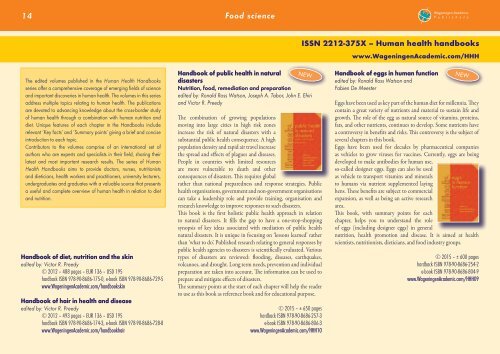Wageningen Academic Publishers - Catalogue 2015
Wageningen Academic Publishers - Catalogue 2015
Wageningen Academic Publishers - Catalogue 2015
You also want an ePaper? Increase the reach of your titles
YUMPU automatically turns print PDFs into web optimized ePapers that Google loves.
14 Food science<br />
<strong>Wageningen</strong> <strong>Academic</strong><br />
P u b l i s h e r s<br />
ISSN 2212-375X – Human health handbooks<br />
www.<strong>Wageningen</strong><strong>Academic</strong>.com/HHH<br />
The edited volumes published in the Human Health Handbooks<br />
series offer a comprehensive coverage of emerging fields of science<br />
and important discoveries in human health. The volumes in this series<br />
address multiple topics relating to human health. The publications<br />
are devoted to advancing knowledge about the cross-border study<br />
of human health through a combination with human nutrition and<br />
diet. Unique features of each chapter in the Handbooks include<br />
relevant ‘Key facts’ and ‘Summary points’ giving a brief and concise<br />
introduction to each topic.<br />
Contributors to the volumes comprise of an international set of<br />
authors who are experts and specialists in their field, sharing their<br />
latest and most important research results. The series of Human<br />
Health Handbooks aims to provide doctors, nurses, nutritionists<br />
and dieticians, health workers and practitioners, university lecturers,<br />
undergraduates and graduates with a valuable source that presents<br />
a useful and complete overview of human health in relation to diet<br />
and nutrition.<br />
Handbook of diet, nutrition and the skin<br />
edited by: Victor R. Preedy<br />
© 2012 – 488 pages – EUR 136 – USD 195<br />
hardback ISBN 978-90-8686-175-0, e-book ISBN 978-90-8686-729-5<br />
www.<strong>Wageningen</strong><strong>Academic</strong>.com/handbookskin<br />
Handbook of hair in health and disease<br />
edited by: Victor R. Preedy<br />
© 2012 – 493 pages – EUR 136 – USD 195<br />
hardback ISBN 978-90-8686-174-3, e-book ISBN 978-90-8686-728-8<br />
www.<strong>Wageningen</strong><strong>Academic</strong>.com/handbookhair<br />
Handbook of public health in natural<br />
disasters<br />
Nutrition, food, remediation and preparation<br />
edited by: Ronald Ross Watson, Joseph A. Tabor, John E. Ehiri<br />
and Victor R. Preedy<br />
NEW<br />
The combination of growing populations<br />
moving into large cities in high risk zones<br />
increase the risk of natural disasters with a<br />
substantial public health consequence. A high<br />
population density and rapid air travel increase<br />
the spread and effects of plagues and diseases.<br />
People in countries with limited resources<br />
are more vulnerable to death and other<br />
consequences of disasters. This requires global<br />
rather than national preparedness and response strategies. Public<br />
health organisations, government and non-government organisations<br />
can take a leadership role and provide training, organisation and<br />
research knowledge to improve responses to such disasters.<br />
This book is the first holistic public health approach in relation<br />
to natural disasters. It fills the gap to have a one-stop-shopping<br />
synopsis of key ideas associated with mediation of public health<br />
natural disasters. It is unique in focusing on ‘lessons learned’ rather<br />
than ‘what to do’. Published research relating to general responses by<br />
public health agencies to disasters is scientifically evaluated. Various<br />
types of disasters are reviewed: flooding, diseases, earthquakes,<br />
volcanoes, and drought. Long term needs, prevention and individual<br />
preparation are taken into account. The information can be used to<br />
prepare and mitigate effects of disasters.<br />
The summary points at the start of each chapter will help the reader<br />
to use as this book as reference book and for educational purpose.<br />
© <strong>2015</strong> – ± 650 pages<br />
hardback ISBN 978-90-8686-257-3<br />
e-book ISBN 978-90-8686-806-3<br />
www.<strong>Wageningen</strong><strong>Academic</strong>.com/HHH10<br />
Handbook of eggs in human function<br />
edited by: Ronald Ross Watson and<br />
Fabien De Meester<br />
NEW<br />
Eggs have been used as key part of the human diet for millennia. They<br />
contain a great variety of nutrients and material to sustain life and<br />
growth. The role of the egg as natural source of vitamins, proteins,<br />
fats, and other nutrients, continues to develop. Some nutrients have<br />
a controversy in benefits and risks. This controversy is the subject of<br />
several chapters in this book.<br />
Eggs have been used for decades by pharmaceutical companies<br />
as vehicles to grow viruses for vaccines. Currently, eggs are being<br />
developed to make antibodies for human use,<br />
so-called designer eggs. Eggs can also be used<br />
as vehicle to transport vitamins and minerals<br />
to humans via nutrient supplemented laying<br />
hens. These benefits are subject to commercial<br />
expansion, as well as being an active research<br />
area.<br />
This book, with summary points for each<br />
chapter, helps you to understand the role<br />
of eggs (including designer eggs) in general<br />
nutrition, health promotion and disease. It is aimed at health<br />
scientists, nutritionists, dieticians, and food industry groups.<br />
© <strong>2015</strong> – ± 600 pages<br />
hardback ISBN 978-90-8686-254-2<br />
e-book ISBN 978-90-8686-804-9<br />
www.<strong>Wageningen</strong><strong>Academic</strong>.com/HHH09


